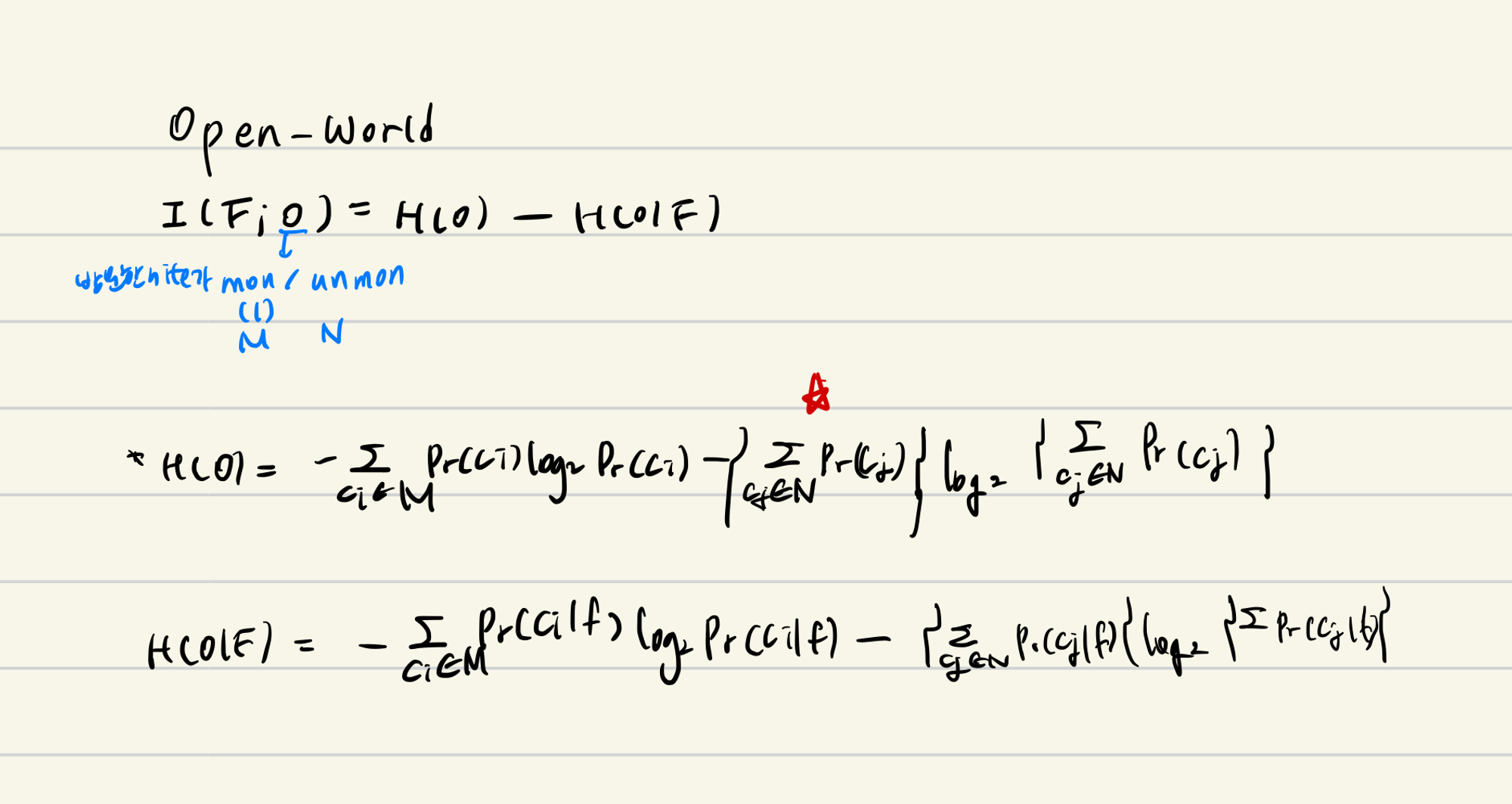| 일 | 월 | 화 | 수 | 목 | 금 | 토 |
|---|---|---|---|---|---|---|
| 1 | 2 | 3 | 4 | 5 | 6 | |
| 7 | 8 | 9 | 10 | 11 | 12 | 13 |
| 14 | 15 | 16 | 17 | 18 | 19 | 20 |
| 21 | 22 | 23 | 24 | 25 | 26 | 27 |
| 28 | 29 | 30 | 31 |
- ML
- face forgery detection
- deepfake detection
- stochastic contraction theory
- ddrm
- pedestrian detection
- neighboring pixel relationships
- ilvr
- diffpir
- conditional diffusion
- semi-supervied learning
- f2dnet
- ccdf
- fourmer
- unconditional ddpm
- Ai
- ssda-yolo
- ddpm
- focal detection network
- unconditional generative models
- diffusion
- facenet
- ddim
- hqs-algorithm
- Triplet
- IR
- image restoration
- daod
- linear inverse problem
- object detection
- Today
- Total
Stand on the shoulders of giants
[paper review] Measuring Information Leakage in Website Fingerprinting Attacks and Defenses 본문
[paper review] Measuring Information Leakage in Website Fingerprinting Attacks and Defenses
finallyupper 2024. 1. 25. 19:29[ updated : 2024-02-17: 요약본 하단 참조]
논문 선택 이유
: Augmentation Project를 위한 인사이트 얻기.
WeFDE의 feature들 가져다가 활용해보기 (trace에서 정보 유출양을 feature별로 보여줌)
⇒ 수학적 서술의 Idea를 얻는게 이 논문을 읽는 것의 목표.
Goal
Tor가 traffic overhead를 minimize하기 위해 website에 대해 불가피하게 leak하는 information의 amount를 측정함.
ex. leaked information : volum, timing, direction of communications
Keys
- validating WF defenses by accuracy alone is flawed
- joint information leakage from a large set of features
- first large-scale information leakage measurement
- new information-theoretic insights upon WF features
Introduction
- Defense Evaluation
- accuracy가 낮은 것 ≠ 낮은 information leakage
- 즉 accuracy는 information leakage를 underestimate함.
- low accuracy doesn’t necessarily mean low information leakage.

- Feature Evaluation
- 기존 = information leakage순으로 feature들을 ranking즉 Feature들간의 relationships를 quantify할 필요가 있다.
- (= coarse-grained evaluations of features)
- → 문제점 : A가 B, C보다 좋을 수 있는데 B&C일때는 모름
- Two Challenges
- Modeling behavior & interaction of WF features
- 정보손실 계산시 curse of dimensionality (차원의 저주)
- 보통 SOTA feature sets는 high-dimensional함.
- WeFDE (Website Fingerprinting Density Estimation, WF 밀도 추정) = Information leakage measurement framework
- Challenges에 관한 Solution
- adaptive kernel density estimation (KDE)
- dimension reduction approaches
- 중복 feature 제거를 위해 feature들의 pairwise mutual information 측정
- Kononenko’s Algorithm, DBSCAN→ threshold 보다 높은 상호정보를 가지도록 그룹화
- 그룹별로 차원축소 및 adaptive kernels 적용

Traffic and its features
T(C) = website C를 방문했을때의 Traffic

- $l_i$
- ≤0 : user가 전송한 패킷
- 0 : server가 전송한 패킷
features (존재하는 traffic features in WF 모두 실험)

System Design
Methodology
Different features may carry different amount of information
(feature 마다 정보량이 다르다.)
ex. 해당 논문의 예제 : Total packet count > transmission time
⇒ 이를 어떻게 정량화할까?(quantify할까?)
⇒ “Mutual Information”

Architecture

1. Website Fingerprint Modeler
traffic feature들은 range가 넓어 histogram대신 AKDE(Adaptive Kernel Density Estimate)

- Proper bandwidths
- continuous features
- → plug-in estimator
- if fails → the-rule-of-thumb approach
- discrete features(→ continuous로 다룸)
- → bandwidth very small (0.001) (각 website가 동일한 constant 사용시 측정에 impact x)
- Properties
- a mixture of continuous & discrete random variables ex. BuFLO : time T안에 complete하면 discrete, 아니면 continuous
- distinguish a continuous-like discrete feature ex. Tamaraw : continuous feature을 discrete하게 만듦 →이런 feature을 recognize
- multivariate form of AKDE (-) The curse of dimensionality ⇒ Mutual information Analyzer를 통한 dim reduction
Mutual Information Analyzer
- Goal = mitigating the curse of dimensionality in multivariate AKDE
- ⇒ dimension reduction 🌟
- normalization → Kvalseth’s method
Entropy and Correlation: Some Comments
For measuring the degree of association or correlation between two nominal variables, a measure based on informational entropy is presented as being preferable to that proposed recently by Horibe [1]. Asymptotic developments are also presented that may be
ieeexplore.ieee.org

- Group by Dependency (의존성에 따라 그룹 나누기)
- Navie Bayes method를 통한 차원 축소
- 조건 = feature set이 conditionally independent → x, 대안 필요! ⇒ 💡 A hybrid of the AKDE and Naive Bayes
- Knononenko’s algorithm (KA)
- 고의존성 feature들을 disjoint group으로 clustering
- 이때 각 group의 conditional independence를 가정함.
- 이후 AKDE를 통해 그룹별로 feature들의 joint PDF 모델링
- 의의
- : Naive bayes가 차원의 저주를 해결하는 방식을 가져오면서도 realistic한 가정을 고려한다는 점에서 의의가 있는 알고리즘.
- DBSCAN
- Threshold $\epsilon$보다 크면 same group, 작으면 diff group 원리
- 구체적으로 threshold보다 작으면 new cluster을 시작함.
- density-based clustering algorithm
- mutual information matrix M → distance matrix D = 1 - M
- → $\epsilon$ tuning을 통한 degree of independence 결정(=0.4)

- Dimension Reduction other approaches
- 다른 feature들로 표현되는 feature들 제거
- theshold(0.9)보다 높은 mutual information을 갖는 feature쌍들을 구함
- 이후 feature들중 하나씩 제거해보면서 찾음
- ⇒ pairwise mutual information
- 모든 feature들의 정보손실을 추론하게 위해 가장 informative한 feature들을 선택함.
- sorting → top n features를 pick out

- 결론 = the information leakage of sufficient top informative features is able to approximate that of the overall features
- +) PCA는 해당 도메인에 쓰기 적절한 차원축소기법이 아니다. 기본적으로 variance도 작아서 성능이 안좋음.
- results

- redundant features are pervasive among the highly informative features
- features from different categories may share much information (that’s why they are clustered together).
- features from same category are not necessarily in the same cluster.
- categories do not necessarily have features to be included in clusters
- 다른 feature들로 표현되는 feature들 제거
- Knononenko’s algorithm (KA)
- 조건 = feature set이 conditionally independent → x, 대안 필요! ⇒ 💡 A hybrid of the AKDE and Naive Bayes
- Navie Bayes method를 통한 차원 축소
Closed-world information leakage
- settings
- Alexa top 100 websites with 55779 visits
- assume : equal prior prob for sites
- feature 3043개의 각 information leakage 계산, categories에 따라 joint leakage 계산-
- results (individual features)

- feature들중 0.02만큼(64개 정도)이 3bit 넘게 information leakage 발생함. 공격자가 이 feature들을 통해 0.125(1/8)만큼으로 가능성을 줄일 수 있다.
- 54.55% features는 1bit보다 덜 잃음 → 거의 feauture들 절반이 공격자가 anonymity set 크기를 절반으로 줄이는데 도움을 주었음. 정보 손실 1bit일때 줄어든 가능성은 p=1/2 → 3bit여서 p=1/(2^3)=1/8
- outgoing packet count ⇒ 반올림 안했을때보다 0.19bit 적은 3.26bit만큼 leak info total packet count와 incoming packet count를 반올림했을때 similar leak increase ⇒ packet count를 반올림하는데 attack에 좋음.
- packet더 많은 download stream보다 incoming stream이 leak bit더 큼
- information leakage of timing features has little difference for upload and download stream.
- the impact of world size on individual feature’s information leakage → x
- Question = 충분히 큰 world size일때 최대 information leakage는 얼마일까
- Closed world
- combined larger world size가 information leakage에 영향 미미
- Open world
- world size가 커질때 ⇒ information leakage 감소
- 측정에 미미함.
 증명(Theorem 2)
증명(Theorem 2)
- Joint Information measurement (Category)
- *categories → Time, Ngram, Transposition, Interval, packet dist, …, CUMUL…
- results
- redundant features가 prevalent했음.
- 그래프를 보면 feature가 더 늘어나도 leakage 증가x(=reach plateau)
- the impact of world size → size 증가시 leakage 증가
- results
Validation
- bootstrapping (appendix A)
- 목적
- : 정보 측정값의 정확도 측정
- 정의
- : 복원 추출을 이용한 통계 기법
- 순서
- 관찰하려는 크기만큼 복원 추출(사이트 마다)
- 1번 가지고 measurement 적용해 information leakage 계산
- 1,2번을 K번 반복해 얻은 information leakage값 K개 기반 CI confidence interval을 찾음.
- measurement validation
- bootstrapping 활용
- (a) top 100 feature들에 대한 confidence intervals
- interval들의 폭이 0.178bit보다 작음
- (b) 15개의 category에 대한 것
- (a) top 100 feature들에 대한 confidence intervals
- bootstrapping 활용
- dataset validation
- bootstrapping 활용(2200개 사이트)
- subsampling
- = bootstrapping용 데이터셋→ 100개 사이트 랜덤 추출(복원x)
- results
- Including different websites in the closed-world setting does make a difference in the measurement, but Figure 10 shows such impact is very limited.
- By bootstrapping, we validate our information leakage results even when the true representative websites are still unknown
Informaton leakage in WF defenses (closed world)
1. Acuracy의 WF defense 입증에 관한 한계성
- 불학실성의 이유 = “all-or-nothing”
- miss했을때 다음 두세번의 시도에 hit한다면 high information leakage
- 한방에 hit → low information leakage
- Accuracy is inaccurate
- Accuracy는 특정 classifier에 대한 의존성 때문에 fail할 것이다.
- 같은 정확도를 갖는 Defense들은 leak하는 정보의 양이 vary하다.
- BuFLO, Tamaraow의 정확도 거의 동일→ 그나마 BuFLO가 더 acc낮아서 얘가 secure하가도 했는데 정보손실량 계산해보니 BuFLO가 2.31bits만큼 더 leak함을 찾아냄.(즉 BuFLO가 덜 secure)
- 정확도로 더 secore한 것 ⇒ leak more information

증명
2. WF defenses’ information leakage의 measurement
- Tamaraw, BuFLO, Supersequence, WTF-PAD, CS-BuFLO로 quantify
- 얘네로 defensed traffic을 생성
- closed-world setting
- information leakage, classification accuracy 동시 평가
- site들에 대해 동일 prior 적용
- 각 defense에 대해 dimension reduction 적용
- 일괄적 KNN classifier
Open-world information leakage
- #가능한 outcome = n+1
- unmon이 많아질수록 오히려 엔트로피가 감소했음.(정보 손실 감소)
- 부분적으로 mon에 대한 prior때문에 정보량이 감소했을것
- world setting의 변화는 카테코리들의 정보손실양에 큰 영향x


Discussion
응용
- Attack = test case의 사이트 방문 확률 계산 + likely destinationd에 대한 prior information → Bayesian 추론
- Bootstrap a defense design
한계
- feature set에 의존함.




